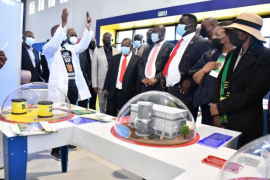
Some two hours’ drive from East London Airport is a small village called Cofimvaba. The village is said to have been named after a nearby stream which, after every time it rains, froths turbulently and resembles milk.
While this was probably the most fascinating fact about this deep rural village for a number of years, something special happened that is set to change the fortunes of young people in the area.
The Department of Science and Innovation unveiled a high-tech, state-of-the-art science centre which Minister Blade Nzimande described as “taking science to the people”, as well as encouraging grass roots innovation.
“The project was aimed at improving education in rural areas by piloting technological innovation for water and sanitation, energy, nutrition and health.
“This science centre will be an educational facility that will house interactive exhibits and will use a hands-on approach to enable the people of Cofimvaba and the surrounding villages to experiment and engage with science.
“It is an expression of bringing science to the people so we also enhance the prospects for grassroots innovation. The centre will also be an integral part of the infrastructure for science communication,” said the Minister of Science and Innovation Blade Nzimande.
The construction and associated civil works of the science centre were jointly funded by the Department of Science and Innovation (DSI) and the Eastern Cape Department of Education to the tune of R47.5 million and R13 million respectively.
Nzimande said the centre will serve 26 high schools in the area, schools that previously relied on a mobile science unit donated by the Department of Science and Innovation and Sasol.
The centre is the first in South Africa to be purpose-designed, with green science, technology and innovation used in the actual building.
The science centre has an off-grid power supply consisting of four renewable energy sources – photovoltaic panels, small-scale wind turbines, hydrogen fuel cells and a battery. Eskom power is available as a back-up.
The structure relies on rainwater harvesting and water recycling for its water supply. To achieve water independence, the toilets are connected to a closed-loop bio-based system that recycles its own water, and greywater is recycled through a constructed wetland.
Constructed using a light steel frame and insulated concrete composite, the building uses solar chimneys for heating and cooling. The centre offers not only science awareness activities and exhibits on various themes, including space science and astronomy, but also a teacher training programme.
It is the Centre for Scientific and Industrial Research (CSIR) - an entity of the department - that designed this centre.
Its design demonstrates how extremely environmentally friendly buildings can be designed, constructed and utilised.
“The centre will produce the energy it needs through solar panels on the rooftop and small-scale wind turbines. This will make it a grid asset, as energy generated on site can be fed back into the grid when the building has a surplus,” Nzimande said.
Ahead of launching the centre, Nzimande, accompanied by Eastern Cape Premier Oscar Mabuyane, took a tour of the facility, which also boasts a planetarium and a robotics exhibit.
“As you will have experienced during the site tour, the science centre building was itself designed to be a science exhibit. This manifests in the site layout, the innovative technologies used in construction, and the technologies to be used for daily operations.
“In addition, a new approach was adopted, in which local scientists based mainly at science councils and universities, were awarded grants to develop some of the exhibits.”
Nzimande said the centre will support the teaching of maths, science and technology in the local schools, as well as act as a teacher development centre to better equip maths and science educators.
“In total, 14 institutions participated, with an equal split between science councils and universities.
“It is exciting that one of the scientists involved – Dr Usisipho Feleni, who is attached to the Institute for Nanotechnology and Water Sustainability at UNISA, is a child of Cofimvaba.
“The moment she learnt about the establishment of this science centre, Feleni felt challenged, stood up and offered to contribute to the centre’s development objectives.
“On another note, this science centre is also a research project. However, we do not yet have deeper knowledge of some of the technologies used in the construction of this building.” – SAnews.gov.za


